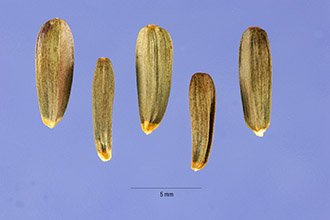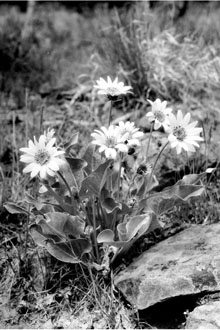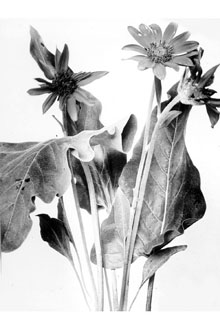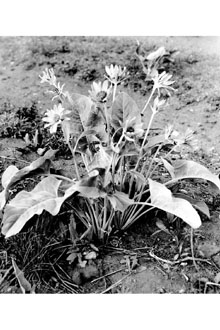Arrowleaf Balsamroot
Scientific Name: Balsamorhiza sagittata (Pursh) Nutt.

| General Information | |
|---|---|
| Usda Symbol | BASA3 |
| Group | Dicot |
| Life Cycle | Perennial |
| Growth Habits | Forb/herb |
| Native Locations | BASA3 |
Plant Guide
Alternate Names
Arrow-leaved balsamroot Breadroot Oregon sunflower Spring sunflower Bupthalmium sagittatum
Uses
Wildlife: A wide variety of wildlife utilizes arrowleaf balsamroot. Deer, elk, bighorn sheep and pronghorn eat the leaves, stems and flowers. Arrowleaf balsamroot can be used to improve spring and summer forage in open rangelands. Ogle and Brazee (2009) list arrowleaf balsamroot as desired forage for cattle, sheep, elk, and pronghorn in spring and summer. Young tissues of arrowleaf balsamroot contain nearly 30% protein (Rickets, 1994). Arrowleaf balsamroot is attractive to native pollinators (Cane, 2011; Ogle and others, 2011b). The seeds are eaten by birds and rodents. It is believed that the presence of arrowleaf balsamroot may serve as an indicator of good habitat for sage-grouse (Klebenow, 1969). Restoration: Because of its showy flowers and dominance on the landscape, arrowleaf balsamroot is commonly used in restoration seedings. The species is believed to have potential for use in oil shale, roadside and mining restoration practices (Wasser, 1982). Attempts to seed arrowleaf balsamroot outside its natural area of occurrence have been largely unsuccessful (Stevens and Monsen, 2004). Medicinal: Arrowleaf balsamroot has been found to contain antibacterial compounds (Matsuura and others, 1996), and has been used as an herbal medicine (Chambers and others, 2006).
Status
Please consult the PLANTS Web site and your State Department of Natural Resources for this plant’s current status (e.g., threatened or endangered species, state noxious status, and wetland indicator values).
Description
General: Sunflower family (Asteraceae). Arrowleaf balsamroot is a long-lived perennial forb native to western North America. The sagittate (arrowhead shaped) leaves are mostly all basal and petiolate, 5 to 45 cm (2 to 18 in) long and 1.5 to 15 cm (0.6 to 6 in) wide. Upper stem leaves are smaller and linear to elliptic. The leaves are silvery white to green. Several flower stems arise from the root crown to a height of 15 to 80 cm (6 to 31 in). The stems bear a solitary floral head with yellow ray and disk flowers. Eight to twenty-five ray flowers with 20 to 60 mm (0.8 to 2.4 in) long petals surround a disk that is 12 to 25 mm in diameter. Both the ray and disk flowers are fertile. The fruit is a glabrous achene with no pappus (Weber, 1997; Welsh and others, 2003). The taproots can be quite large reaching 2.7 m (8.8 ft) long and 10 cm (4 in) in diameter. Deep lateral roots can run horizontally for 60 to 100 cm (2 to 3 ft) (Weaver, 1915).
Ethnobotany
Many tribes used arrowleaf balsamroot medicinally. The Blackfoot used root smoke to treat body aches (Hellson, 1974). The Blackfoot, Gosiute, Kutenai, Paiute, Sanpoil and Shoshoni used a poultice made from the roots to treat blisters, sores, insect bites, bruises and wounds (Hellson, 1974; Chamberlin, 1911; Hart, 1992; Train and others, 1941; Ray, 1932). Root infusions were used by the Cheyenne and Flathead to treat fevers, whooping cough, and tuberculosis. They also used them as a urinary aid and cathartic (Grinnell, 1905; Hart, 1992; Ray, 1932). Root decoctions were also used by the Cheyenne, Miwok, Shoshoni and Paiute for headaches, stomachaches, rheumatism, venereal disease, and as an eyewash and birthing aid (Barrett and Gifford, 1933; Train and others, 1941; Grinnell, 1972). The Flathead and Okanagan-Colleville tribes used poultices of leaves to treat burns (Hart, 1992; Turner and others, 1980). The leaves, stems, roots and seeds of arrowleaf balsamroot were commonly eaten by several western tribes. The Flathead, Kutenai, Montana, Nez Perce, Okanagan-Colville, Paiute, Thompson and Ute tribes ate raw or cooked leaves and young stems (Hart, 1992, Blankinship, 1905; Turner and others, 1980; Mahar, 1953; Steedman, 1928; Teit, 1928). Arrowleaf balsamroot seeds were a staple for many tribes. They were eaten raw, ground into flour for making cakes, used for cooking oil, or mixed with other foods by the Atsugewi, Gosiute, Klamath, Miwok, Montana, Nez Perce, Okanagan-Colville, Paiute and Thompson tribes (Garth, 1953; Chamberlin, 1911; Coville, 1897; Barrett and Gifford, 1933; Blankinship, 1905; Hart, 1992; Turner and others, 1980; Teit, 1928; Murphey, 1990; Mahar, 1953; Steedman, 1928). Distribution: Arrowleaf balsamroot occurs throughout western North America from Alberta and British Columbia, east to the Dakotas and south to Colorado and Arizona. For current distribution, please consult the Plant Profile page for this species on the PLANTS Web site. Habitat: Arrowleaf balsamroot grows on open hillsides and prairies at mid to upper elevations in the Intermountain West and Rocky Mountain regions. It is commonly associated with sagebrush communities including basin big sagebrush, mountain big sagebrush, threetip sagebrush and infrequently with Wyoming big sagebrush. Arrowleaf balsamroot can also be found growing in mountain shrub, pinyon-juniper, ponderosa pine, Douglas fir and aspen plant communities (Welsh and others, 2003).
Adaptation
Arrowleaf balsamroot is adapted to fine to medium textured soils in areas typically receiving 30 to 65cm (12 to 25 in) of annual precipitation. However populations are known in Wyoming big sagebrush sites receiving about 23 cm (9 in) of annual precipitation. Because of the deep taproot, arrowleaf balsamroot tolerates fire, grazing, trampling and drought (Stevens and Monsen, 2004). It prefers well-drained silty to loamy soils with a pH range of 6.5 to 8.0 (Stevens and Monsen, 2004; USDA NRCS 2011). The plants are often found in open, full sun, but can also tolerate partial shade. It occurs naturally from 300 to 2,700 m (1,000 to 9,000 ft) in elevation.
Establishment
Arrowleaf balsamroot should be drilled seeded into a weed free seed bed in late fall. Seeding depth should be set to 0.6 to 1.3 cm (0.25 to 0.5 in). Broadcast seeding can be successful if the seed is subsequently covered. The full stand seeding rate, based on 25 pure live seeds (PLS) per foot at 30 cm (12 in) spacing, is 21 kg/ha (19 lb/ac). When planted in a mixture, the seeding rate should be adjusted according to the proportion of arrowleaf balsamroot in the mix. Young seedlings develop slowly and are not competitive against more vigorous species. Alternate row seeding is recommended (Stevens and Monsen, 2004). Dense stands may take 10 years or more to develop.
Management
Arrowleaf balsamroot should be used as a minor component of seed mixtures. Management strategies should be based on the key species in the established plant community. Grazing should be deferred on seeded lands for at least two growing seasons to allow for full stand establishment (Ogle and others, 2011a; Stevens and Monsen, 2004). Blaisdell and Mueggler (1956) found that 2,4-D applications sprayed on sagebrush rangelands resulted in heavy damage to arrowleaf balsamroot. Arrowleaf balsamroot is tolerant of fire due to its deep taproot. Following fires, the plants will often regenerate from the persisting caudex (Smith and Fisher 1997).
Pests and Potential Problems
Rodents and birds feed on the seed (Skinner, 2004), and can be problematic in seed production fields. Insect damage to seed can be significant, and stored seed may require pesticide treatment and cold storage (Skinner, 2004; Stevens and Monsen, 2004). Mold has been observed on seedlings in greenhouse and growth chamber production (Chambers and others, 2006).
Environmental Concerns
Concerns
Concerns
Arrowleaf balsamroot is native to western North America. It will spread under favorable conditions but does not pose any environmental concern to native plant communities.
Seed and Plant Production
Plant Production
Plant Production
Plant Production: Seed of arrowleaf balsamroot requires stratification for germination (Chambers and others, 2006; Young and Evans, 1979). Seed should be sown into containers to a depth of 0.6 to 1.3 cm (0.25 to 0.5 in) and lightly covered with pea gravel and then placed outdoors in late fall or early winter for natural stratification. This species requires low temperatures, 0 to 10° C, (32 to 50° F) for germination (Baskin and others 2002; Chambers and others, 2006; Young and Evans, 1979). Germination begins in March and continues for 3 or more weeks (Skinner, 2004). Chambers and others (2006) showed increased germination with ethylene treatment. Seeds sown in media soaked in an ethylene solution of 10 ml to 14.4 l water averaged 28% germination, while the non-treated control treatment averaged 2.5% germination. Transplanting is difficult. Plants should be handled with care to prevent damage to the root system (Chambers and others, 2006; Skinner, 2004). The plants develop slowly and take 3 or more years after establishment to produce flowers. Seed Production: Seed production fields are typically planted at 91 to 107 cm (36 to 42 in) row spacing to facilitate between-row cultivation. Seed should be planted at a depth of 0.6 to 1.3 cm (0.25 to 0.5 in) at 60 PLS/m (20 PLS/ft) of row. Seed is sown in the fall to allow for natural over winter stratification. Germination is reported to be erratic with new plants appearing for 2 to 3 years after planting (Stevens and others, 1996). Once established arrowleaf balsamroot is very competitive against weeds. When necessary, weeds are controlled by hand or with between- row cultivation. Pre-emergence and spot treatments of herbicides can also be used once the plants are well established (Stevens and others, 1996). Fertilizer is generally not recommended. Fields are irrigated to a cumulative total of 38 to 51 cm (15 to 20 in) per year including natural precipitation. The soils should not be over saturated. Overhead irrigation should be avoided during pollination. Arrowleaf balsamroot achenes. Photo by Steve Hurst @ USDA-NRCS PLANTS Database Plants are slow to develop and may take 3 to 5 years to reach full production (Stevens and others, 1996); however, once established seed fields will produce for 20 to 30 years. Arrowleaf balsamroot requires insect visitation for seed production. Cane (2005) found that no seed was set in monitored plants without bee visitation, and significantly more seed was set with outcrossing. He further calculated that at least 165 nesting females of Osmia californica are needed to pollinate a one-hectare (67 bees/ac) seed production field of arrowleaf balsamroot. Seed crops are often damaged by frost. Seed in wildland stands is often lost due to insect and wildlife use. Harvest can be done by hand, with a vacuum-type harvester or by direct combining. Timing of seed harvest is critical. Mature viable seed shatters readily, leaving only immature and insect-damaged seed. This low-quality seed often appears to be normal and healthy and is often mistakenly harvested and sold (Stevens and Monsen, 2004). Seed cleaning is easy with the seed falling readily from the flower heads. The heads can also be rubbed, lightly milled or brushed to remove maximum seed. Seed can be cleaned with screen cleaners and indent cleaners. Insect damaged seed is lighter than viable seed and can be separated with gravity or air (Stevens and Monsen, 2004). Well cleaned seed should have purities of 95% or greater with approximately 40% viability (Barner, 2009; Stevens and Monsen, 2004). Peak yields of 84 to 140 kg/ha (75 to 125 lbs/ac) have been reported (Stevens and others 1996). There are approximately 128,000 seeds/kg (58k seeds/lb) (USDA NRCS 2011) at 100% purity. . Seed should be stored at cold temperatures (1 to 4° C [33 to 40° F]) (Barner, 2009; Skinner, 2004). Seed is susceptible to insect damage and can be treated with pesticide prior to storage (Plummer and others, 1968; Stevens and others, 1996). Cultivars, Improved, and Selected Materials (and area of origin) Wildland collected seed is available from commercial sources. There are currently no commercial releases of arrowleaf balsamroot.
References
Barner, J. 2009. Propagation protocol for production of Balsamorhiza sagittata (Pursh) Nutt. seeds; USDA FS - R6 Bend Seed Extractory, Bend, Oregon. In: Native Plant Network. URL: http://www.nativeplantnetwork.org (accessed 30 December 2011). Moscow (ID): University of Idaho, College of Natural Resources, Forest Research Nursery. Barrett, S.A., and E.W. Gifford. 1933. Miwok Material Culture. Bulletin of the Public Museum of the City of Milwaukee 2(4):11p. Baskin, C.C., and J.M. Baskin. 2002.
Propagation
protocol for production of container Balsamorhiza sagittata (Pursh) Nutt. plants; University of Kentucky, Lexington, Kentucky. In: Native Plant Network. URL: http://www.nativeplantnetwork.org (accessed 30 December 2011). Moscow (ID): University of Idaho, College of Natural Resources, Forest Research Nursery. Blaisdell, J.P., and W.F. Mueggler. 1956. Effect of 2,4-D on forbs and shrubs associated with big sagebrush. Journal of Range Mangement. 9(1):38-40. Blankinship, J.W. 1905. Native Economic Plants of Montana. Bozeman. Montana Agricultural College Experimental Station, Bulletin 56. Cane, J.H. 2005. Pollination needs of arrowleaf balsamroot, Balsamorhiza sagittata (Heliantheae; Asteraceae). Western North American Naturalist. 65(3): 359-364. Cane, J.H. 2011. Specialist Osmia bees forage indiscriminately among hybridizing Balsamorhiza floral hosts. Oecologia 167:107-116. Chamberlin, R.V. 1911. The Ethno-Botany of the Gosiute Indians of Utah. Memoirs of the American Anthropological Association 2(5):331-405. Chambers, K.J.; Bowen, P.; Turner, N.J.; and P.C. Keller. 2006. Propagation protocol for production of container Balsamorhiza sagittata (Pursh) Nutt. plants; Rancho Santa Ana Botanic Garden, Davis, California. In: Native Plant Network. URL: http://www.nativeplantnetwork.org (accessed 30 December 2011). Moscow (ID): University of Idaho, College of Natural Resources, Forest Research Nursery. Coville, F.V. 1897. Notes On The Plants Used By The Klamath Indians Of Oregon.. Contributions from the U.S. National Herbarium 5(2):87-110. Garth, T.R. 1953. Atsugewi Ethnography. Anthropological Records 14(2):140-141 Grinnell, G.B. 1905. Some Cheyenne Plant Medicines. American Anthropologist 7:37-43. Grinnell, G.B. 1972. The Cheyenne Indians - Their History and Ways of Life Vol.2. Lincoln. University of Nebraska Press (p. 189). Hart, J. 1992. Montana Native Plants and Early Peoples. Helena. Montana Historical Society Press Hellson, J.C. 1974. Ethnobotany of the Blackfoot Indians. Ottawa. National Museums of Canada. Mercury Series (p. 78). Klebenow, D.A. 1969. Sage grouse nesting and brood habitat in Idaho. Journal of Wildlife Management. 233(3): 649-662. Mahar, J.M. 1953. Ethnobotany of the Oregon Paiutes of the Warm Springs Indian Reservation. Reed College, B.A. Thesis. Matsuura, H., Saxena, G., Farmer, S.W., Hancock, R.E.W., and G.H.N. Towers. 1996. An antibacterial thiophene from Balsamorhiza sagittata. Planta Med. 62: 65-66. Mueggler, W.F. 1950. Effects of spring and fall grazing by sheep on vegetation of the Upper Snake River Plains. Journal of Range Management 3(4): 308-315. Murphey, E.V.A. 1990. Indian Uses of Native Plants. Glenwood, Ill. Meyerbooks. Originally published in 1959 Ogle, D., and B. Brazee. 2009. Estimating initial stocking rates. USDA-NRCS Technical Note No. 3. Boise, Idaho. 39p. Ogle, D., St. John, L., Stannard, M., and L. Holzworth. 2011a. Technical Note 24: Conservation plant species for the Intermountain West. USDA-NRCS, Boise, ID-Salt Lake City, UT-Spokane, WA. ID-TN 24. 57p. Ogle, D., Tilley, D., Cane, J., St. John, L., Fullen, K., Stannard, M., and P. Pavek. 2011b. Technical Note 2A: Plants for pollinators in the Intermountain West. USDA-NRCS. Boise, ID. ID-TN2A. 40p. Plummer , A.P., Christensen, D.R., and S.B. Monsen. 1968. Restoring big game range in Utah. Publ. 68-3. Salt Lake City, UT. Utah Division of Fish and Game. 183p. Ray, V.F. 1932. The Sanpoil and Nespelem: Salishan Peoples of Northeastern Washington. University of Washington Publications in Anthropology, Vol. 5. Ricketts, M. 1994. Cutting ranching costs: optimizing forage protein value. Rangelands. 16(6): 260-264. Skinner, D.M. 2004. Propagation protocol for production of container Balsamorhiza sagittata (Pursh) Nutt. plants; USDA NRCS - Pullman Plant Materials Center, Pullman, Washington. In: Native Plant Network. URL: http://www.nativeplantnetwork.org (accessed 30 December 2011). Moscow (ID): University of Idaho, College of Natural Resources, Forest Research Nursery. Smith, J.K., and W.C. Fischer. 1997. Fire ecology of the forest habitat types of northern Idaho. Gen. Tech. Rep. INT-GTR-363. Ogden, UT: USDA Forest Service, Intermountain Research Station. 142p. Steedman, E.V. 1928. The Ethnobotany of the Thompson Indians of British Columbia. SI-BAE Annual Report 45:441-522. Stevens, R., Jorgensen, K.R., Young, S.A., and S.B. Monsen. 1996. Forb and Shrub
Seed Production
Guide for Utah. Utah State University Extension. Logan, Utah. 51p. Stevens R., and S.B. Monsen. 2004. Forbs for seeding range and wildlife habitats. In: S.B. Monsen, R. Stevens, and N.L. Shaw [compilers]. Restoring western ranges and wildlands. Fort Collins, CO: USDA Forest Service, Rocky Mountain Research Station. General Technical Report RMRS-GTR-136-vol-2. p. 425-491. Teit, J.A. 1928. The Salishan Tribes of the Western Plateaus. SI-BAE Annual Report #45. Train, P., J.R. Henrichs, and W.A. Archer 1941
Medicinal
Uses of Plants by Indian Tribes of Nevada, Washington DC, Use soil moisture sensors to measure the soil moisture of Arrowleaf Balsamroot., U,S, Department of Agriculture (p, 50, 51), Turner, N,J,, Bouchard, R,, and D,I,D, Kennedy, 1980 Ethnobotany of the Okanagan-Colville Indians of British Columbia and Washington, Victoria, British Columbia Provincial Museum (p, 80), [USDA NRCS] USDA Natural Resources
Conservation
Service. 2011. The PLANTS Database, version 3.5. URL: http://plants.usda.gov (accessed 29 Dec 2011). Baton Rouge (LA): National Plant Data Center. Wasser, C.D. 1982. Ecology and culture of selected species useful in revegetating disturbed lands in the West. FWS/OBS-82/56. Washington DC: USDI Fish and Wildlife Service, Western Energy and Land
Plant Traits
Growth Requirements
| Temperature, Minimum (°F) | -38 |
|---|---|
| Adapted to Coarse Textured Soils | No |
| Adapted to Fine Textured Soils | Yes |
| Adapted to Medium Textured Soils | Yes |
| Anaerobic Tolerance | None |
| CaCO3 Tolerance | High |
| Cold Stratification Required | Yes |
| Drought Tolerance | High |
| Fertility Requirement | Low |
| Fire Tolerance | High |
| Frost Free Days, Minimum | 150 |
| Hedge Tolerance | None |
| Moisture Use | Medium |
| pH, Maximum | 8.0 |
| pH, Minimum | 6.5 |
| Planting Density per Acre, Maxim | 4800 |
| Planting Density per Acre, Minim | 1200 |
| Precipitation, Maximum | 25 |
| Precipitation, Minimum | 8 |
| Root Depth, Minimum (inches) | 14 |
| Salinity Tolerance | Low |
| Shade Tolerance | Intermediate |
Morphology/Physiology
| After Harvest Regrowth Rate | Slow |
|---|---|
| Toxicity | None |
| Resprout Ability | No |
| Shape and Orientation | Erect |
| Active Growth Period | Spring |
| Bloat | None |
| C:N Ratio | Medium |
| Coppice Potential | No |
| Fall Conspicuous | No |
| Fire Resistant | No |
| Flower Color | Yellow |
| Flower Conspicuous | Yes |
| Foliage Color | Green |
| Foliage Porosity Summer | Moderate |
| Foliage Porosity Winter | Porous |
| Fruit/Seed Color | Brown |
| Nitrogen Fixation | None |
| Low Growing Grass | No |
| Lifespan | Long |
| Leaf Retention | No |
| Known Allelopath | No |
| Height, Mature (feet) | 2.0 |
| Growth Rate | Moderate |
| Growth Form | Multiple Stem |
| Fruit/Seed Conspicuous | No |
| Foliage Texture | Medium |
Reproduction
| Vegetative Spread Rate | None |
|---|---|
| Small Grain | No |
| Seedling Vigor | Low |
| Seed Spread Rate | Slow |
| Fruit/Seed Period End | Summer |
| Seed per Pound | 58438 |
| Propagated by Tubers | No |
| Propagated by Sprigs | No |
| Propagated by Sod | No |
| Propagated by Seed | Yes |
| Propagated by Corm | No |
| Propagated by Container | No |
| Propagated by Bulb | No |
| Propagated by Bare Root | No |
| Fruit/Seed Persistence | No |
| Fruit/Seed Period Begin | Spring |
| Fruit/Seed Abundance | High |
| Commercial Availability | Routinely Available |
| Bloom Period | Late Spring |
| Propagated by Cuttings | No |
Suitability/Use
| Veneer Product | No |
|---|---|
| Pulpwood Product | No |
| Protein Potential | Medium |
| Post Product | No |
| Palatable Human | No |
| Palatable Graze Animal | Medium |
| Palatable Browse Animal | High |
| Nursery Stock Product | No |
| Naval Store Product | No |
| Lumber Product | No |
| Fodder Product | No |
| Christmas Tree Product | No |
| Berry/Nut/Seed Product | No |



